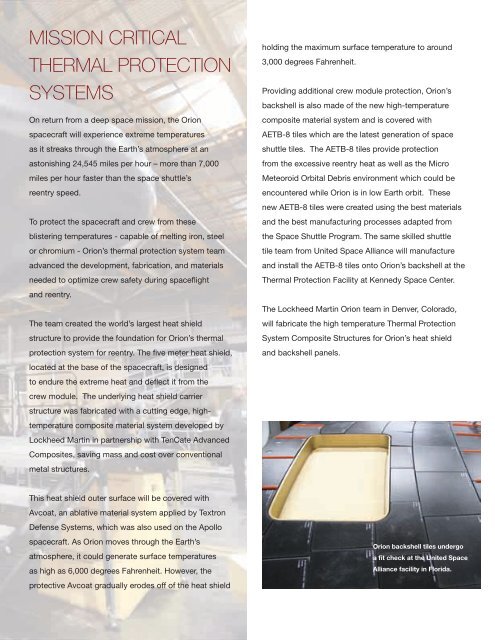Orion: America's Next Generation Spacecraft (4.7 Mb PDF) - NASA
Orion: America's Next Generation Spacecraft (4.7 Mb PDF) - NASA
Orion: America's Next Generation Spacecraft (4.7 Mb PDF) - NASA
You also want an ePaper? Increase the reach of your titles
YUMPU automatically turns print PDFs into web optimized ePapers that Google loves.
MISSION CRITICAL<br />
THERMAL PROTECTION<br />
SYSTEMS<br />
On return from a deep space mission, the <strong>Orion</strong><br />
spacecraft will experience extreme temperatures<br />
as it streaks through the Earth’s atmosphere at an<br />
astonishing 24,545 miles per hour – more than 7,000<br />
miles per hour faster than the space shuttle’s<br />
reentry speed.<br />
To protect the spacecraft and crew from these<br />
blistering temperatures - capable of melting iron, steel<br />
or chromium - <strong>Orion</strong>’s thermal protection system team<br />
advanced the development, fabrication, and materials<br />
needed to optimize crew safety during spaceflight<br />
and reentry.<br />
The team created the world’s largest heat shield<br />
structure to provide the foundation for <strong>Orion</strong>’s thermal<br />
protection system for reentry. The five meter heat shield,<br />
located at the base of the spacecraft, is designed<br />
to endure the extreme heat and deflect it from the<br />
crew module. The underlying heat shield carrier<br />
structure was fabricated with a cutting edge, hightemperature<br />
composite material system developed by<br />
Lockheed Martin in partnership with TenCate Advanced<br />
Composites, saving mass and cost over conventional<br />
metal structures.<br />
holding the maximum surface temperature to around<br />
3,000 degrees Fahrenheit.<br />
Providing additional crew module protection, <strong>Orion</strong>’s<br />
backshell is also made of the new high-temperature<br />
composite material system and is covered with<br />
AETB-8 tiles which are the latest generation of space<br />
shuttle tiles. The AETB-8 tiles provide protection<br />
from the excessive reentry heat as well as the Micro<br />
Meteoroid Orbital Debris environment which could be<br />
encountered while <strong>Orion</strong> is in low Earth orbit. These<br />
new AETB-8 tiles were created using the best materials<br />
and the best manufacturing processes adapted from<br />
the Space Shuttle Program. The same skilled shuttle<br />
tile team from United Space Alliance will manufacture<br />
and install the AETB-8 tiles onto <strong>Orion</strong>’s backshell at the<br />
Thermal Protection Facility at Kennedy Space Center.<br />
The Lockheed Martin <strong>Orion</strong> team in Denver, Colorado,<br />
will fabricate the high temperature Thermal Protection<br />
System Composite Structures for <strong>Orion</strong>’s heat shield<br />
and backshell panels.<br />
This heat shield outer surface will be covered with<br />
Avcoat, an ablative material system applied by Textron<br />
Defense Systems, which was also used on the Apollo<br />
spacecraft. As <strong>Orion</strong> moves through the Earth’s<br />
atmosphere, it could generate surface temperatures<br />
as high as 6,000 degrees Fahrenheit. However, the<br />
protective Avcoat gradually erodes off of the heat shield<br />
<strong>Orion</strong> backshell tiles undergo<br />
a fit check at the United Space<br />
Alliance facility in Florida.
















